Unleashed moments
Smart social media has turned pet photographer Kaylee Greer into a big commercial success.
• March 2016 issue
When Kaylee Greer photographed Guinness the chocolate lab in January 2014, she came prepared in the usual way: with a generous supply of dog treats, plenty of peanut butter, and toys to keep the subject engaged. Things that weren’t in her arsenal: a shot list, a detailed plan, or any preconceived notions as to how the commercial shoot would go.“I just go in and fly by the seat of my pants, I guess,” says Greer, laughing. “But I think that’s kind of the beauty in it—not knowing exactly what you’re going to get until you get there. There’s magic in that.”
In this case, magic came at the end of the frigid, five-hour shoot, when Greer and one of her crew members discovered that Guinness loved leaping up to catch snowballs, which would instantly break apart in his mouth. The result was a stunning image of the playful lab suspended mid-air, looking directly at the camera, with snow flying all around him.
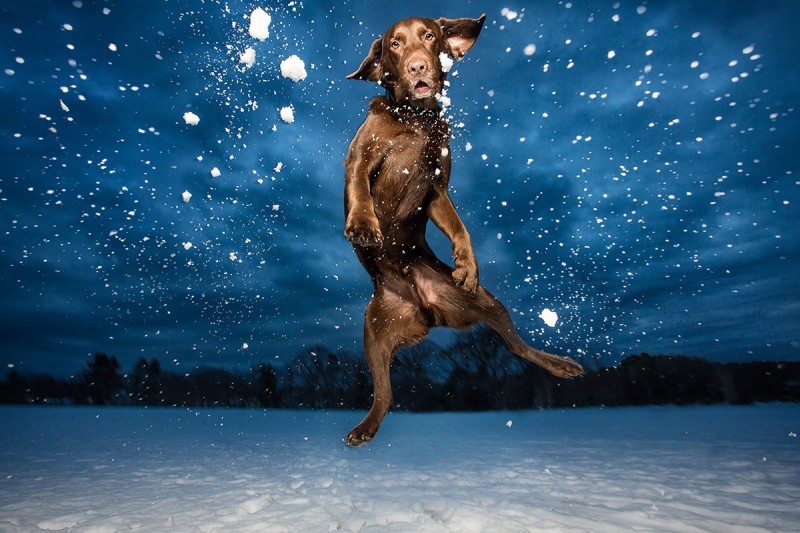
“That was a good example of just going into it and saying, Let’s try this, and it worked out really well,” Greer recalls. “It was just a tiny moment. But I think that’s what people notice about my work. It’s not staged. It’s really just a moment.”
Ruff start
This spontaneous spirit has served Greer well as she’s built her Boston-based business, Dog Breath Photography, over the past five years. During that time she’s evolved from a part-time pet photographer juggling a handful of clients and a job at an Apple retail store into a sought-after international shooter with a mix of private and commercial clients who book as much as a year in advance and keep her calendar full.
But there was a time when Greer, a lifelong dog lover and self-described “crazy dog lady,” thought her pet photography career—featuring mostly dogs and the occasional cat or horse client—was over before it had even really begun. When she started to dabble in taking dog photos after college, she didn’t have a dog living with her. So she had to search for potential models in the homes of friends and relatives and at her local dog park.
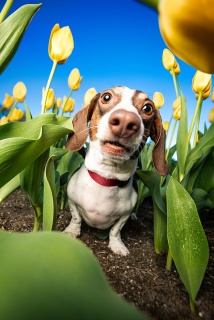
“It was super creepy,” jokes Greer, describing how she’d use a long lens to focus on strangers’ dogs. “People [at the dog park] would notice, and I’d ask, ‘Do you mind if I photograph your dog? I’m just practicing.’ That’s when I thought I should probably just give this up. These aren’t the landscapes I was photographing in college. These are dogs running by at 95 miles an hour, and of course all my photos were blurry.”
Things really changed once Greer started to volunteer on her one day off each week at the Massachusetts Society for the Prevention of Cruelty to Animals. There, she took photos of adoptable dogs and posted the shots online to help the animals find permanent homes.
“[The photos] weren’t amazing when I first started. I wasn’t great,” she says. “But I felt like I was making a difference. I would put these photos online and people would see them, and all of sudden you were a voice for this dog that had no voice of its own.”
With her credit on the adoption photos, Greer found some recognition through social and traditional media, and the first few private clients began to trickle in. By the time she had her 15th shoot, she was ready to leave her day job and pursue dog photography full time.
Online success
Now Greer shoots about four sessions a week for private clients throughout New England. And her commercial work for such brands as PetSmart, Wellness pet food, and Kurgo dog supplies have taken her to locations like Los Angeles, Spain, and Australia. Her work has appeared in publications including Dogs Today and on the Huffington Post website. But Greer still gets the majority of her work, both private and commercial, pretty much the same way she did in those early days: through the Internet.
“Honestly, the Internet has been a gift to me,” Greer says. “I’ve never done any kind of paid advertising ever. Literally last week, I just got an agent, but that’s the first step I’ve ever taken toward reaching out and trying to find commercial clients on my own.”
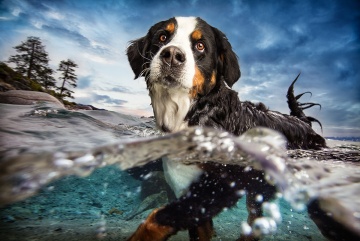
Greer believes the secret to her online success lies in diligently tagging all her images with keywords like “commercial” and “dog photography,” sharing stories along with strong images on Facebook, and taking advantage of websites such as 500px.com, where photographers can curate image galleries for anyone to view. “I’ve had a number of ad agencies say that they found me through 500px,” she says.
However, while commercial clients might find her the same way private clients do, the two types of shoots differ a great deal. Greer’s private pet shoots typically take place in some outdoor location that’s driving distance from her home base of Boston, and she has plenty of free rein creatively. She uses an online questionnaire that clients fill out before the session to give her some background on the dog she’s photographing and to help select the setting, although she gets a lot of inspiration for the images when she meets a dog in person.
“You’re trying to capture the things that these dogs do that bring so much joy into their owners’ lives,” Greer says. “Those are the things [the owners are] trying to freeze in time so that they can hold onto it forever.”
While some commercial clients give Greer similar leeway to express her creativity, others come with a very specific vision. These are the rare cases in which she might go into a session with a shot list or work in a studio rather than outside.
Canine technique
When it comes to technique, Greer says certain things work well in all types of dog photography. One key lesson she teaches in workshops: Get low. Greer believes a dog photographer should be on a dog’s level, pretty much lying down, the entire session.
“You’re always seeing the dogs from your standing level. That’s ordinary,” she explains. “So when you get down on his direct level, all of a sudden it takes on this new perspective and power. This is how he sees the world.”
Once she has her images in camera, Greer uses post-production tools to make her subjects shine. She whitens the whites, and cleans up any stains or dust around the eyes (“I swear I spend my life Photoshopping out eye boogies,” she says). She brightens the irises, as well.
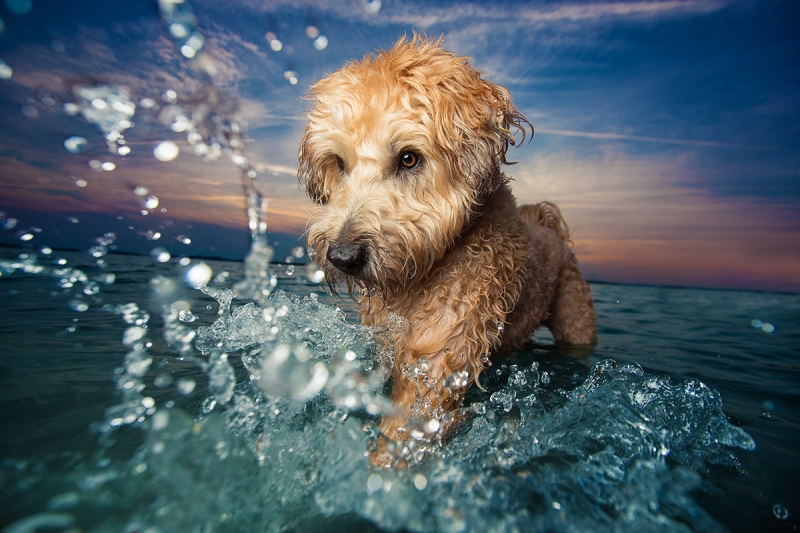
“On top of that, I’ll do a high-pass sharpening and put that in the whole eye. And that makes it a little bit glossy looking, wet-looking almost,” Greer says.
But more than any technical skills, Greer says the most important quality a dog photographer can bring to the table is patience. She allows about two to three hours for an average session and usually spends the first 20 minutes just letting the dog get used to her.
“Sometimes it will take me a solid 30 minutes to get a shot off,” she says. “There are so many factors that have to line up. You can’t get frustrated. Dogs can sense stress, and so they get a little worked up when you’re stressed out.”
This is where Greer’s laid-back approach to her craft and her appreciation for canines becomes her guiding light.
“The point to really drive home is, nothing goes according to plan, so don’t worry,” she says. “Let a dog teach you something—that it’s important to just live in the moment and enjoy the beauty that’s around you right in that second.”
Deblina Chakraborty is a writer in Atlanta.

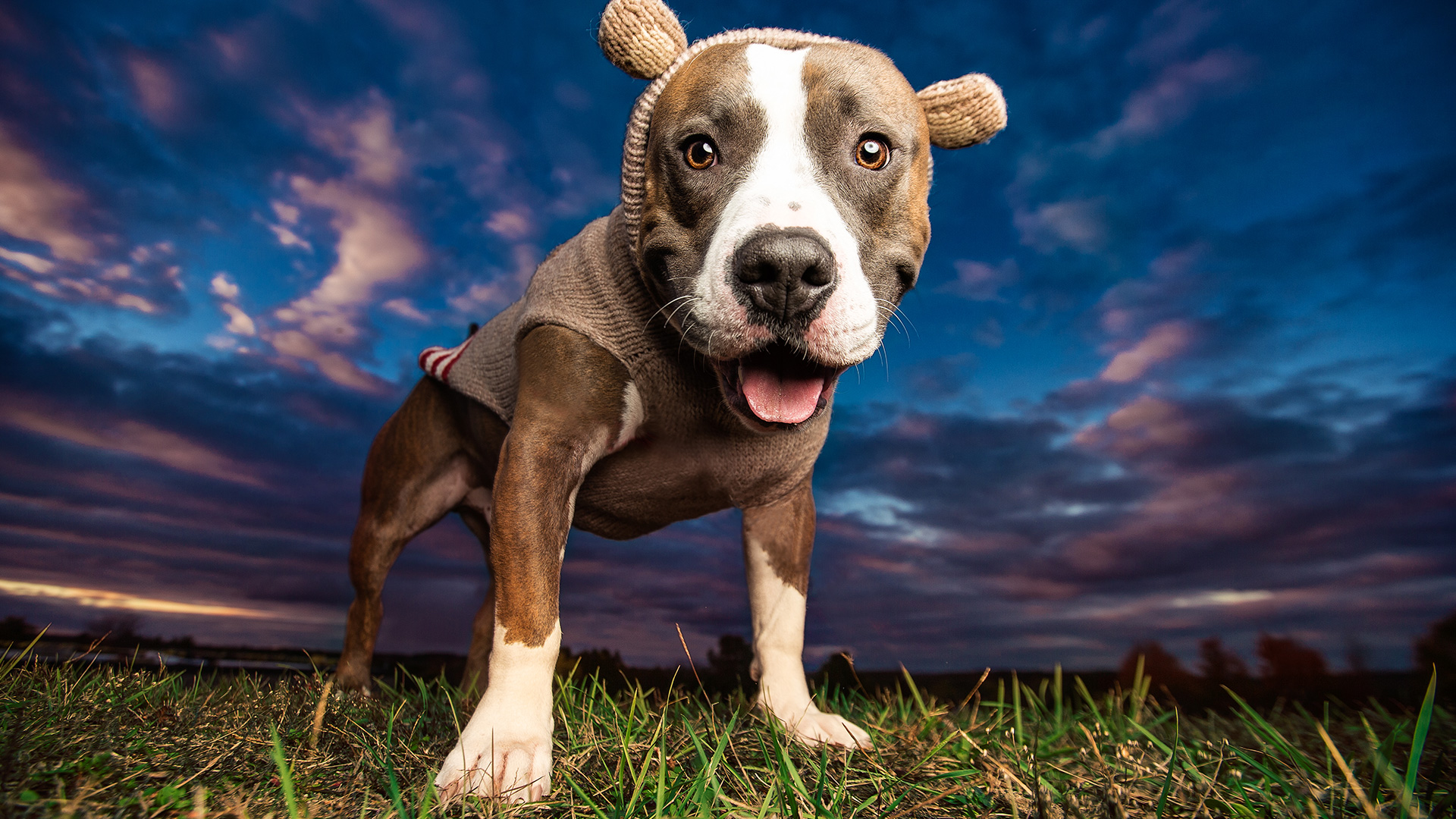
 View Gallery
View Gallery

